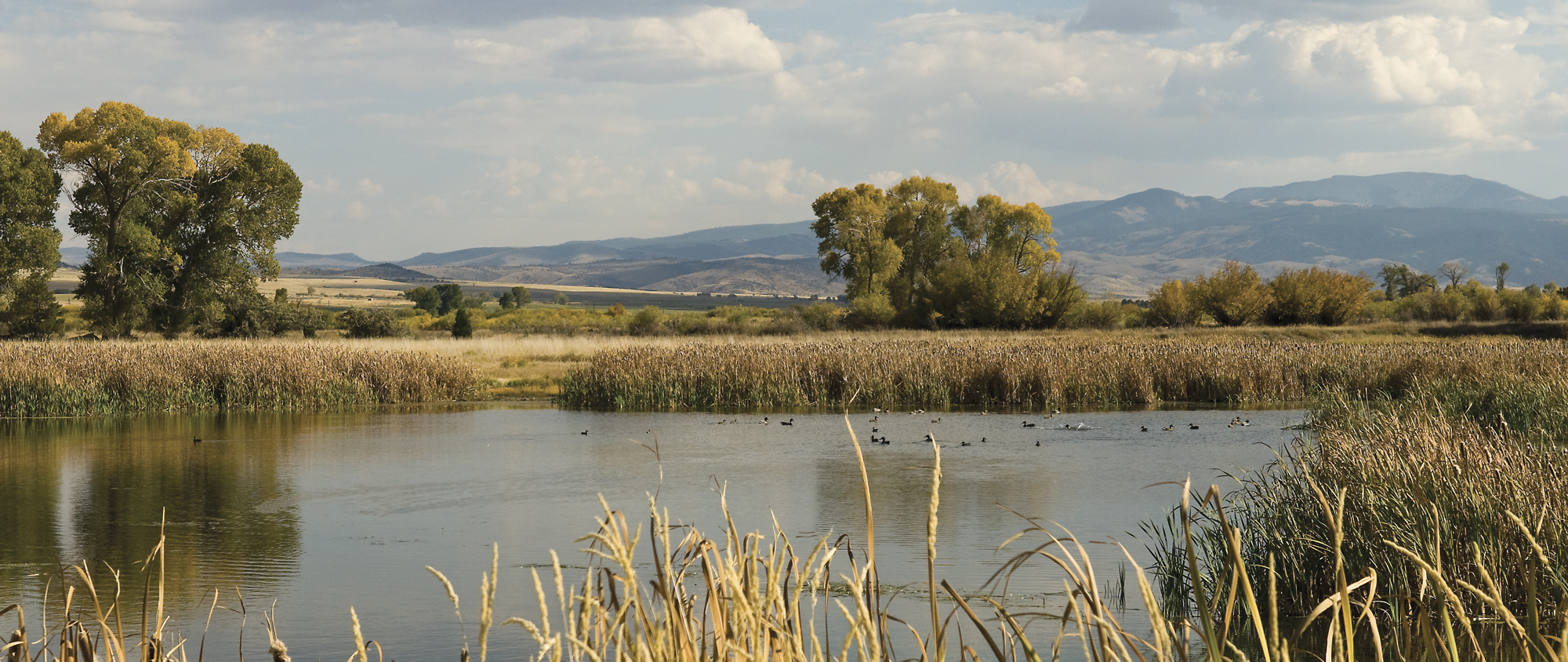
23 Jul Building a Legacy: the Ruby Habitat Foundation
CRAIG WOODSON, NEWSPAPER PUBLISHER AND LIFELONG OUTDOORSMAN, had fished all over the world, from New Zealand to Russia to Argentina, by the time he and his wife, Martha, began visiting Southwest Montana’s Ruby River Valley in the mid-1980s. And it wasn’t long before they focused their sights on finding a home they could retire to on their newly found homewater. Just to be sure, they looked from Livingston west, and decided they did indeed prefer the Ruby Valley. “We thought it was one of the prettiest regions, maybe not as dramatic as some spots, but very pretty. And I felt the potential here was exceptional.”
The potential he refers to is the 1,100 acres of woods, fields and water that has come to be known as Woodson Ranch, in Sheridan, Mont. And it’s just what Craig Woodson had hoped for — a personal paradise of more than 8.5 miles of fishable water along the Ruby River.
“All my life I was in the office, looking out the window at nice days, and when my day off came, it would be crappy,” says Woodson in a soft Texas drawl. “So my ambition when I retired was to have some place where I could be there all the time, didn’t matter if I missed a day. I could just have great weather, get out when I wanted to, not worry about it.”
Now, in addition to reclaimed and enhanced fishing opportunities, the ranch sports the results of years of a late-found passion Woodson has cultivated for conservation experimentation. But these enhancements are a far cry from the tired, working ranch the Woodsons purchased in the fall of 1992.
He had clear ideas of what he wanted — and didn’t want — to happen with the property. “I didn’t want to be a gentleman rancher and have someone else run the whole shooting match.” And then it seemed as if fate stepped in, in the form of local fifth-generation Ruby Valley rancher Les Gilman.
“I first met Craig 16 years ago,” says Gilman, a tall, handsome man with a ready smile. “And I approached him with the idea of leasing his ranch from him, to run it while he played.” But the new ranch owner had other things in mind. “The problem with that,” Woodson had told him, “is you’ll be thinking about you, but who’s going to think about me? I want you to work for yourself, but think about me.” That meeting laid the foundation for what is now Gilman’s own company, Ranch Resources, with a staff of five that manages 30 ranches across Montana, from Kalispell to Columbus, for all manner of absentee landowners.
But back in the fall of ’92, none of them had any idea of the work that awaited them at Woodson’s new spread. “It was a wreck,” he says, in the no-nonsense approach he often employs with his dealings at the ranch. “The stream out front was protected by car bodies — almost every decade was represented. Wherever you went on the ranch there was something rusting.”
While a few initial conservation efforts began in the fall of ’92, the real work was to begin in earnest the following spring. And then catastrophe struck. “We acquired this place in the fall of ’92, with full possession scheduled for April or May of ’93,” says Woodson. “Well, in April I promptly had my stroke.”
The incident proved devastating for Woodson, who had been looking forward to life at a more leisurely pace on his stretch of homewater in his beloved valley. Instead he would spend the next six months learning all over again how to walk and talk. He was told by doctors to keep his hopes realistic, in such cases significant improvements were rare. But they hadn’t counted on the fact that this man had a dream ranch in Montana that needed his attention.
While Woodson fought his way back to eventual recovery, in his absence work at the ranch commenced. The first years were spent bringing the place back to its former basic state through clean up and restoration. Woodson’s early goals, says Gilman, were clear-cut and straightforward: “Craig wanted Woodson Ranch to be a recreational property with an agricultural base.”
In other words, a working ranch with good fishing. And so, in addition to Gilman, ranch employees now included the indispensable husband-and-wife team of Juventino and Louisa Colado, who hired on as live-in caretakers, and whose children would grow up on the ranch. “We had a load of work that needed doing,” says Woodson, “and they were willing, able and ready to go to work. They weren’t afraid to pick up junk and trash.”
They enacted a rigorous program of enhancement of the ranch’s basic infrastructure that included improvements to irrigation, buildings and crop and grazing land. And eventually the place came to be known as the Woodson Ranch for Agriculture and Recreational Purposes.
Over the next few years, the Woodsons built a home, intended as a fishing cabin, on the banks of the Ruby. And since all of their family was in Texas when they were in Montana, fishing and enjoying themselves, says Woodson, “We discovered you didn’t have to invite anybody from Texas twice in the summer and they’d be here. So we ended up building a guest house next door.”
During this period, enhancement was the operative word at the ranch. “We were always doing something to make it better. Always had designs to maintain and enhance the agricultural side of the ranch so we’d have a decent place to fish. We made miles of river roads and trails for good access to the property and to the river so people didn’t traipse through someplace we didn’t want them to be,” says Woodson.
The extensive network of roads and trails offered Woodson vast access to his ranch’s 8.5 miles of fishable streams, and numerous ponds. The man, who but a few short years before had had a major stroke, was now bicycling throughout his dream ranch, overseeing improvements and ensuring that his plans were brought to fruition. Among them were numerous wetland enhancements, and the formation of Cattail Creek, based on Woodson’s own plan that took advantage of naturally occurring groundwater, giving it shape and a home to a thriving brown trout population.
“I intended this ranch as a private fishery,” says Woodson, “a place for family to retreat to. But a funny thing happened,” he says. He made friends.
“Craig came in quietly and started doing things here. And he got some suspicious looks,” says Gilman. “People were curious, but he kept on quietly doing things. And now he’s respected even by the hardcore, self-reliant, traditional ranchers.”
The “things” he did — extensive conservation projects involving new and unorthodox, but effective, land and crop treatments and a spate of conservation preservation and enhancement projects — came about largely through Woodson’s efforts to return the land and its waters to a state that predated the intensive, traditional cattle ranching that had, over time, stripped it of its biodiversity and reduced it largely to a monoculture property.
Gilman, himself a rancher in the same valley, came around to appreciate Woodson’s unique and specific vision for the property. He points out that a lot of the ranch’s early projects didn’t offer quick or apparent results. “While the wetland enhancement work is not specifically fisheries related, riparian wildlife health in general enhances the value of the property, especially for wildlife use.” Today, all manner of wildlife, from common and rare varieties of songbirds to an overabundance of whitetail deer, plus waterfowl and a thriving fishery, attest to the accuracy of Woodson’s instincts about the potential of the property.
THE WOODSON RANCH STORY would likely have gone on in this manner for years had it not been for one of the most formative events in recent American history. Like so many people in the uncertain days following the attacks of Sept. 11, 2001, Craig and Martha Woodson felt an urgency to instill a deeper sense of security in their lives, to create something of lasting value not only for their family, but for the good of the Ruby River Valley, for southwest Montana and, perhaps, with the help of whatever ripple effect their conservation efforts might have, to offer benefit to the wider world beyond.
That Christmas, Craig and Martha pulled the entire family — three sons, two daughters, plus spouses and children — together at their place in Texas. “I just popped out with: ‘What do you kids think you want when I die?’” Woodson smiles and says, “I am prone to saying things like that.” They told him, resoundingly, that they wanted to preserve the ranch so they could continue to enjoy it well into the future. This pleased the Woodsons, but left them with the task of figuring out how to avoid family squabbles over the property.
“I talked with the state and with tax attorneys, and we came up with the most obvious answer: Set up a foundation.” And more specifically, they hit on the idea of a support foundation, something that would save them having to go through daunting learning curves and get them up to speed quickly. The only problem they found with being a support foundation is that you have to have someone to support.
Over the next several months, the Woodsons, along with their attorneys and Gilman, met with and entertained offers from a variety of well-known organizations, but none felt right. “There was always something missing,” said Woodson. “We wanted something we felt would complement our intentions. And so we ended up with Montana Land Reliance.”
The Montana Land Reliance (MLR), a conservation land trust established in 1978, and recognized as one of the most effective in the country, proved to be the ideal organization for Woodson’s fledgling foundation to support.
With its primary interest as land conservation, the Woodsons found that the MLR’s goals were very much in line with Craig’s intentions for his ranch. In its 30 years, MLR has helped nearly 700 private landowners in Montana protect their properties — some 800,000 acres and 1,400 miles of fishable water — with conservation easements, which allow the land to remain undeveloped and, where appropriate, to continue as working ranch land. This sounded just right to the Woodsons, and in short order they all came to what Woodson calls a “good-old-boy agreement without lawyers.”
Within a few months, they found themselves as a 509A, a support foundation to Montana Land Reliance. Ruby Habitat Research Foundation (later shortened to Ruby Habitat Foundation) was set up with a board of directors consisting of three family members, two MLR representatives and two people from the Ruby Valley. In this configuration, Woodson points out, no family members can have a majority on the board.
“It gave us a nice opportunity to create a non-profit with insight and oversight of MLR, which has been in operation for 30 years,” he says. “And this allowed us to work together right away toward a common goal of conservation and education so much faster than most any other way we could have gone.”
Rock Ringling, managing director of Montana Land Reliance and Ruby Habitat Foundation board member, regards the Woodsons’ vision as a throwback to a nearly forgotten sense of loyalty to community. “You just don’t see that enough anymore. It’s a testament to them that they stuck to their vision and that our organizations’ visions parallel so nicely.”
For the Woodsons, the true value of the foundation’s relationship with MLR is that these 1,100 acres of high-resource value in the heart of the Ruby Valley will stay open, valued and useful for a long time to come. During its six years, the foundation and MLR have helped ensure that its guiding principle, “Education and inspiration,” has both broadened the scope of and given shape to the foundation’s programs. These include countless projects, from reseeding native grasses to cutting-edge experiments with crop rotation to ongoing experiments with predator- and deer-proof fencing.
Last summer the ranch hosted a river resource day that taught local kids about riparian health, wetlands and soils. “We had experts here talking about fisheries and aquatic life,” says Gilman. “And we had a poet at the fishing cabin who recited for them, then they worked on their own poems. The kids loved it.”
Woodson views the place as his own classroom, too, and likes to experiment with the “lost” or overlooked areas of the ranch that might not otherwise be useful, or at least used. “I like to call them corners and borders,” he says. “For example, up by Hill House we have 20 acres of alfalfa, but along the ditch where we planted willows, we’ve had a brood of pheasants there each year for a few years now.”
IT DOESN’T TAKE ANGLING VISITORS long to figure out that river access at Woodson Ranch was laid out by a fly fisherman. None of that spine-jarring, pickup-bouncing, washout-dodging access here. Instead, the number and location of the trails, from raised and mowed walking paths through wetlands to full gravel roads leading to parking areas, offer anglers unparalleled access to extensive and varied river and stream frontage — 4.5 miles on the Ruby itself and another four or so on Alder Stream and Clear Creek, a braid of the Ruby.
“Craig laid in a hospital bed for six months, not thinking he’d ever walk again — but he’s a fighter, he brought himself back,” says Gilman with obvious admiration in his voice. “And he used that time to come up with plans for the ranch. We built these roads so he could get around the ranch. And it doesn’t hurt that they also help everyone’s enjoyment of the property.”
The foundation’s strong management of its riverine resource began initially with the removal of the cattle from the rivers to let the banks heal themselves. To date this has proven the most effective method of bringing back and enhancing the fishery, though other vital steps include planting native grasses and willows to help stabilize the banks, and limiting the number of people who fish the streams.
Angling at the ranch is exclusively fly fishing and catch-and-release only, to preserve and protect the resource. And while the privilege of fishing there is donation based, appreciation of and inspiration by the good works practiced there are all that are asked of recreational visitors to the ranch. “People coming from the East and West Coasts are willing to contribute money to the foundation for it to be open to them, so I turned the fishing over to the foundation and MLR uses it as a place to bring their guests,” explains Woodson. “They give them a good experience, give them our conservation pitches, then later on they ask for contributions to the foundation and to MLR.”
These anglers often stay at Hill House, a spacious, comfortable home built on the far side of the river overlooking the ranch and valley, and from there are given access to the ranch waters with virtually no chance of bumping into another fisherman just behind the next clump of willows.
“We charge a bit for a stay at Hill House, to cover expenses, then it’s donation based,” says Gilman. “It’s a first-come, first-serve basis, though we’ve never told anybody no. But we have had to say we can’t get you in this year due to scheduling.”
Over the years, Rock Ringling has had the opportunity to fish the ranch — all in the line of duty, of course — and while he uses the opportunity to show other recreational land buyers the conservation possibilities open to them, he can’t help but enjoy the experience, too. “The Ruby, and especially that stretch, is an exceptional dry fly fishery. Just a tremendous resource.”
In addition to the Hill House, the ranch offers anglers a handful of what Gilman calls “access points.” An old log cabin was moved from its original site near the ranch house to a favored but secluded spot, tucked into a curve of the Ruby. Now refurbished, the cabin offers a couple of bunks, an outhouse, woodstove, cozy sitting porch and a propane generator. “It’s a roughing-it cabin,” says Martha Woodson. “Perfect if you need a place to warm up.”
Access to the Woodson Ranch is controlled by the foundation to assure a quality experience and to maintain the ranch’s most vital asset, its natural resource values. “We manage recreational access, not only to the fishing, but to hunting, bird watching, trail walking, because ultimately this is not a public fishing access point, and we don’t try to represent it that way. But if the public asks, and if there’s space available on the schedule, then we let them in. That’s how we preserve the resource.”
Woodson adds, “It’s no different than any other private ranch property in the state. Ranch owners manage access to their property. The only difference here is that the ranch is a base for foundation purposes.”
The four ponds, varied in shape, are each 10 to 14 feet deep, and offer a number of mini pools and countless riffles. “Trout love it right in there,” Gilman points toward the clear, curving run through the lush grasses. “It’s a tremendous fishery. Some people like the size of this stream, what Craig calls a ‘Martha-size stream,’ the challenge of sneaking up on it. Then again some people drive right by it to get to the river. Others use both, morning on the river, and then they hit the ponds in the afternoon.”
The Ruby is primarily a brown trout fishery, though rainbow trout, arctic grayling and whitefish also call it home. While it’s not a tailwater, there is a reservoir dam that controls the flow, which means the ranch can sustain the flows over a longer period of time. These elements contribute to its success as a season-long fishery. And unlike many other Western rivers, this stretch of the Ruby has never been shut down due to high temperatures.
The river is also a significant contributor to the viability of the Jefferson River, though the overall effects of the dam haven’t been detrimental. “I suppose we had Westslope cutthroat at one time, “ says Gilman, “but I don’t know as there are any left, except possibly way in the upper reaches. Maybe it’s a good thing that the Ruby dam has prevented the brown trout from invading the Westslope population that’s left. That depends on how you want to look at the dam.”
If the Woodson family is in residence and using the property, public access can be limited, particularly in spring, summer and early fall, but, Gilman says, there are still plenty of opportunities on the calendar for the public throughout that time. “We try to limit fishing access to one group on the ranch at a time, not to exceed four rods at a time, so they feel like they can have an individual experience. They get to go up and down the river by themselves without fear of tripping over another angler. We believe the river can tolerate one rod per mile every other day, but that would add up to more than that if you put people there, there and there, “Gilman points to likely spots along the river. “We still have our ag operations going on all the time, but that generally doesn’t impair their enjoyment.”
“A big part of fly fishing is the place where you fly fish,” says Martha Woodson, herself an avid angler. “People who come out here are always impressed with the beauty of the place, and that enhances the fishing experience. And especially today, where it’s getting difficult to have a fairly quiet fishing experience without having 25 or 30 people fishing next to you.”
People interested in pursuing recreational access to Woodson Ranch, including fishing, hunting, bird watching and trail walking, should call Ranch Resources, 406.842.5010, to inquire about availability.
ON ANY GIVEN DAY throughout the year something interesting is happening at Woodson Ranch. The results of these projects may not be evident for years, but that doesn’t seem to trouble Woodson or Gilman. Both men regard the foundation’s reach as large and long, and hopes are that multigenerational families will follow Woodson’s lead and keep their own ranches intact. “We hope to influence new recreational owners,” says Gilman, “to do something more with their properties than the same old thing … or worse.”
Woodson’s overall guiding theme is conservation with purpose. “He really has a focus and purpose behind the things he does here,” says Gilman. “Why he’s creating wetland habitat, perennial food plots — he’s always working toward that conservational purpose. He’s always challenging me in good ways. I admire very much the fact that Craig has not just talked the talk but he’s walked the walk. I take heart from that and I admire Craig and Martha both for creating such an important legacy.”
Supporting the Legacy
IN KEEPING WITH RUBY HABITAT FOUNDATION’S mission to educate and encourage responsible resource management, Woodson Ranch hosts a number of public events, stewardship gatherings and watershed meetings, most often at the Waldie-Kanouse Visitor Center, which serves as a gathering place for groups and individuals to study or use as a base from which to explore the extensive Ruby Valley Interpretive Nature Trail system that winds along the river. The trail system was co-built by a local fourth-grade class and Ruby Valley Future Farmers of America (FFA) students.
The Waldie-Kanouse Visitor Center is a set of reclaimed log buildings named in memory of two men who loved fishing at the ranch, both good friends of the Woodsons and patrons of the foundation. Each passed away in recent years and named the foundation as a favored memorial. Scott Waldie was an avid fly fisherman and local guide who is best known as the author of the Travers Corners trilogy of books set in the Ruby River Valley, and M.C. “Bud” Kanouse was an artist and angler who, like Waldie, lived to fish the Ruby.
In 1999, the Woodsons, Scott and Jane Waldie, Bud and Joan Kanouse and bookbinder Greg Campbell collaborated to assemble a special collector’s edition of Waldie’s second book, Return to Travers Corners. The result was a leather bound offering of 26 books, labeled A-Z, and each signed, lettered, housed in a presentation slipcase and accompanied with an original Kanouse watercolor. The entire effort was donated to the foundation. The process was repeated when Waldie’s third book, Travers Corners: The Final Chapters, was released, with the same generous donation made by all artists involved. This second series was accompanied with a set of hand-tied flies, patterns referenced in the book, by local guide and fly tyer, Bob Flynn. After Waldie died in 2006, a third and final collector’s set was assembled, this time of the author’s first book in the series, Travers Corners. Each of these 26 books is accompanied with an original watercolor by artist Linda Darsow Sutton.
An additional creation designed to accompany the special collector’s edition trilogy was made available in 2007 by Waldie’s friend, Ruby Valley rodmaker Eric Ramsey, of Ramsey Rods. The “Scott Waldie Special,” a handmade two-piece bamboo fly rod, is now available on a limited basis, and is paired with a custom-crafted leather tube by Arne Mason. Only 26 rods will be made, four per year until the A-to-Z series is sold out.
A limited number of complete sets of the Travers Corners trilogy and the “Scott Waldie Special” fly rod are available, along with a two-night stay at Hill House at Woodson Ranch and two days of fishing, for up to four guests, for a package price of $10,000. The books and rod cost $4,000, with the remaining $6,000 as a tax-deductible contribution to the Ruby Habitat Foundation. Contact the Ruby Habitat Foundation office for further information: 406.842.5010.
- Les Gilman, executive director of Ruby Habitat Foundation, inspects the Ruby River at Woodson Ranch in Sheridan, Montana.
- A Ruby River trout jumps near the fisherman’s cabin.
- A rolling cylinder aerates water converging from the managed wetland into Clear Creek, a braid of the Ruby River.
- Martha and Craig Woodson (founders of Ruby Habitat Foundation) pause for a portrait near the Ruby River, at Woodson Ranch in Sheridan, Montana.
- Clockwise from upper left: A heron flies over the Ruby River. • Waterfowl thrive with excellent cover in the restored wetlands. • Ring-neck pheasant find ample cover throughout the ranch’s 1,100 acres. • Whitetail deer graze at Woodson Ranch.




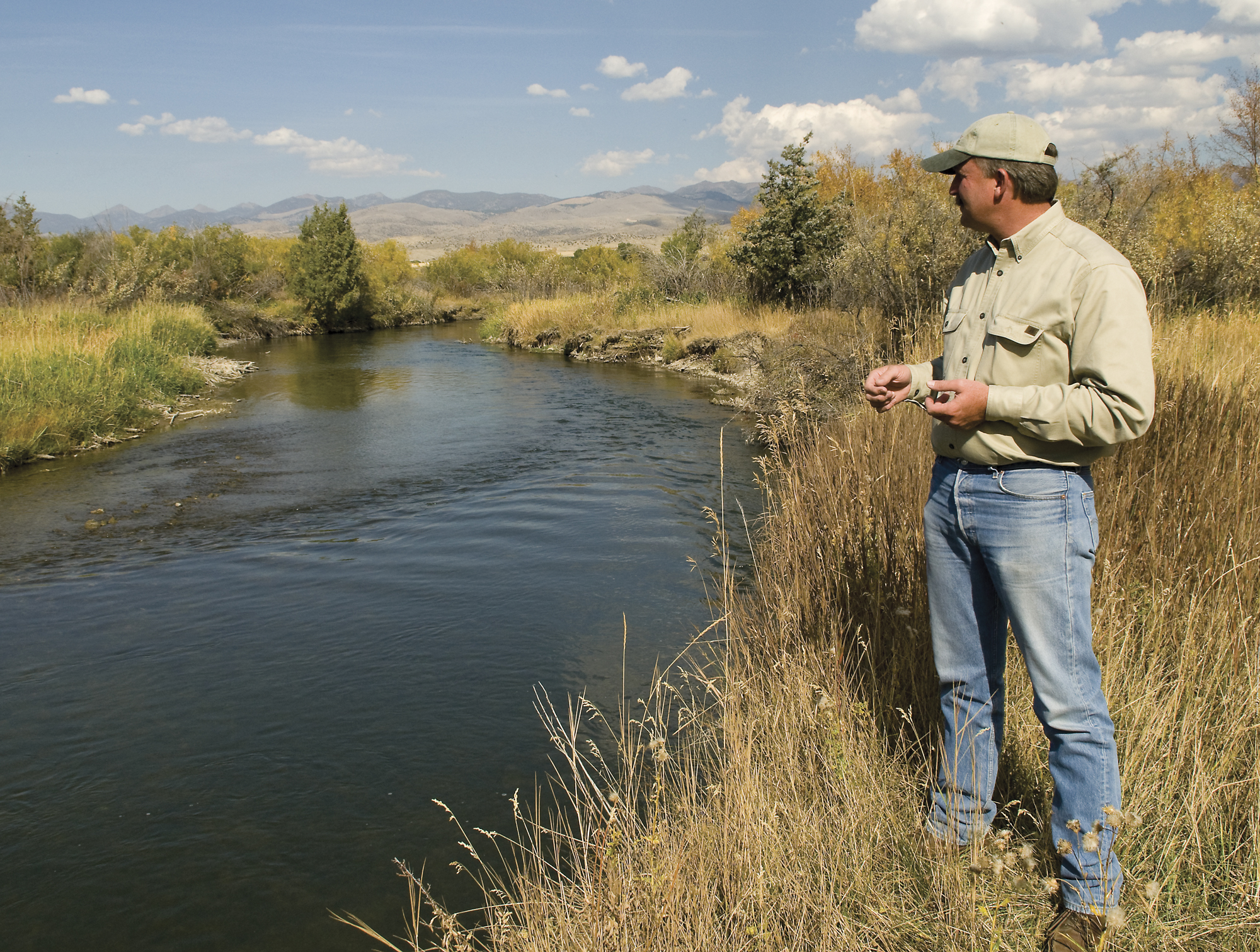

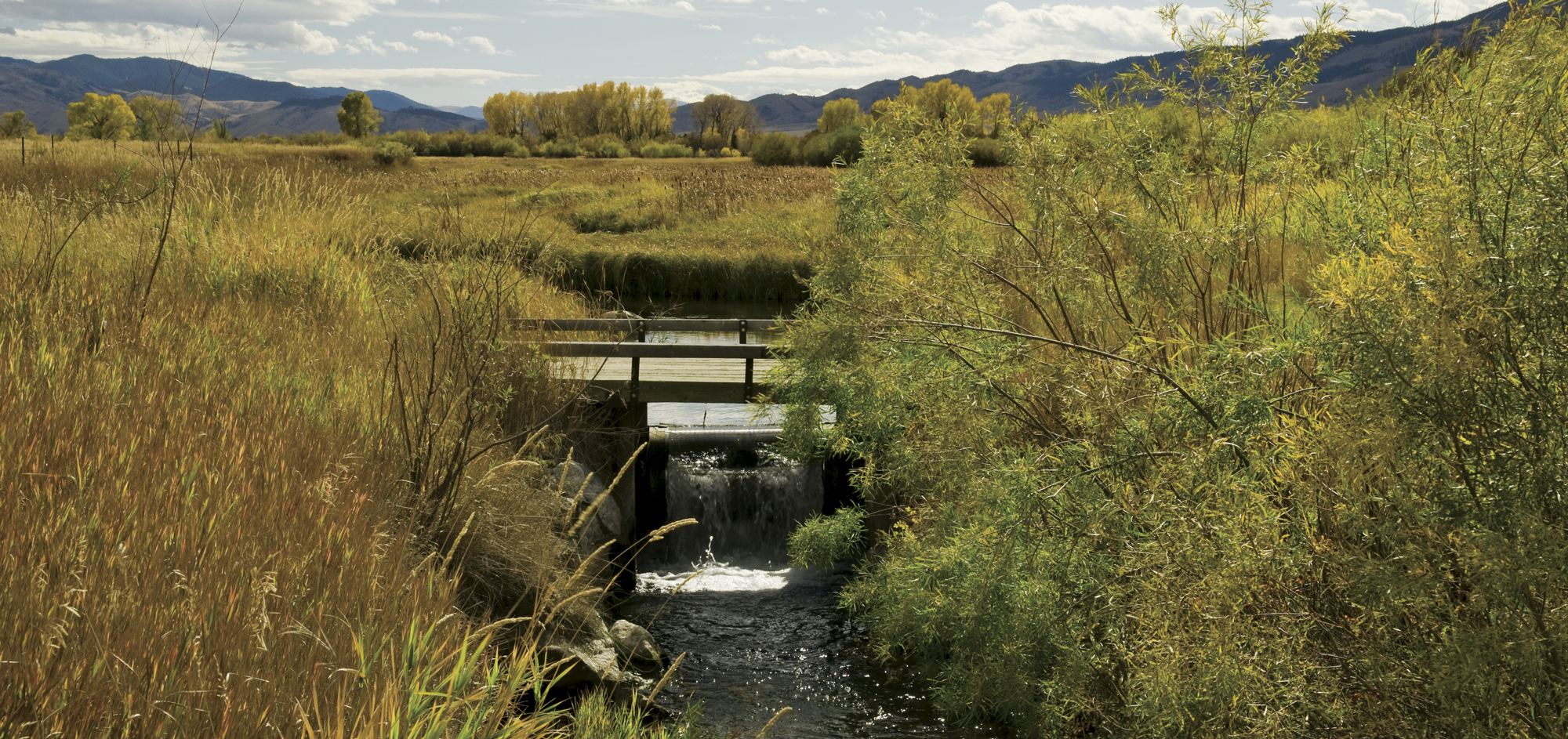

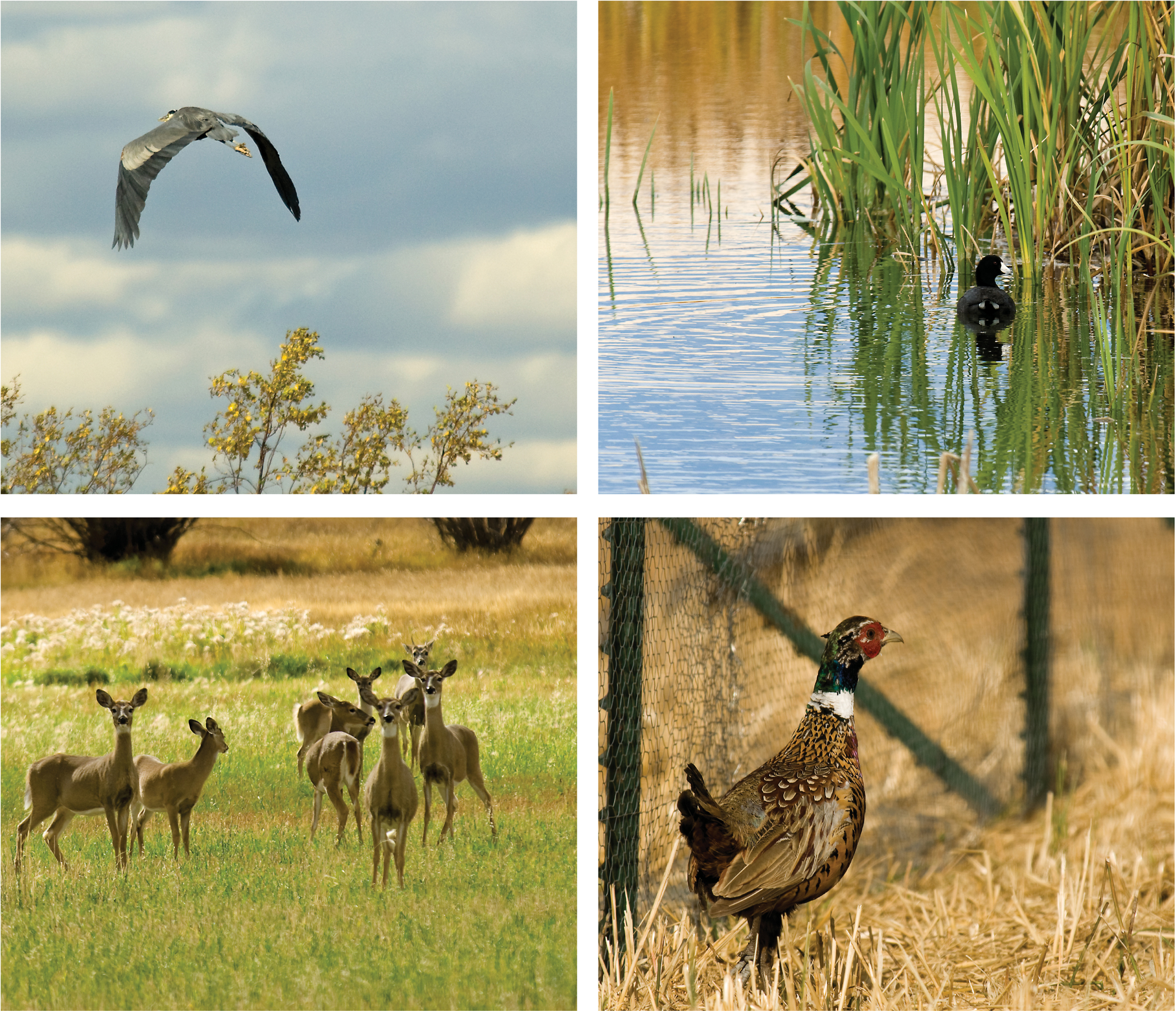
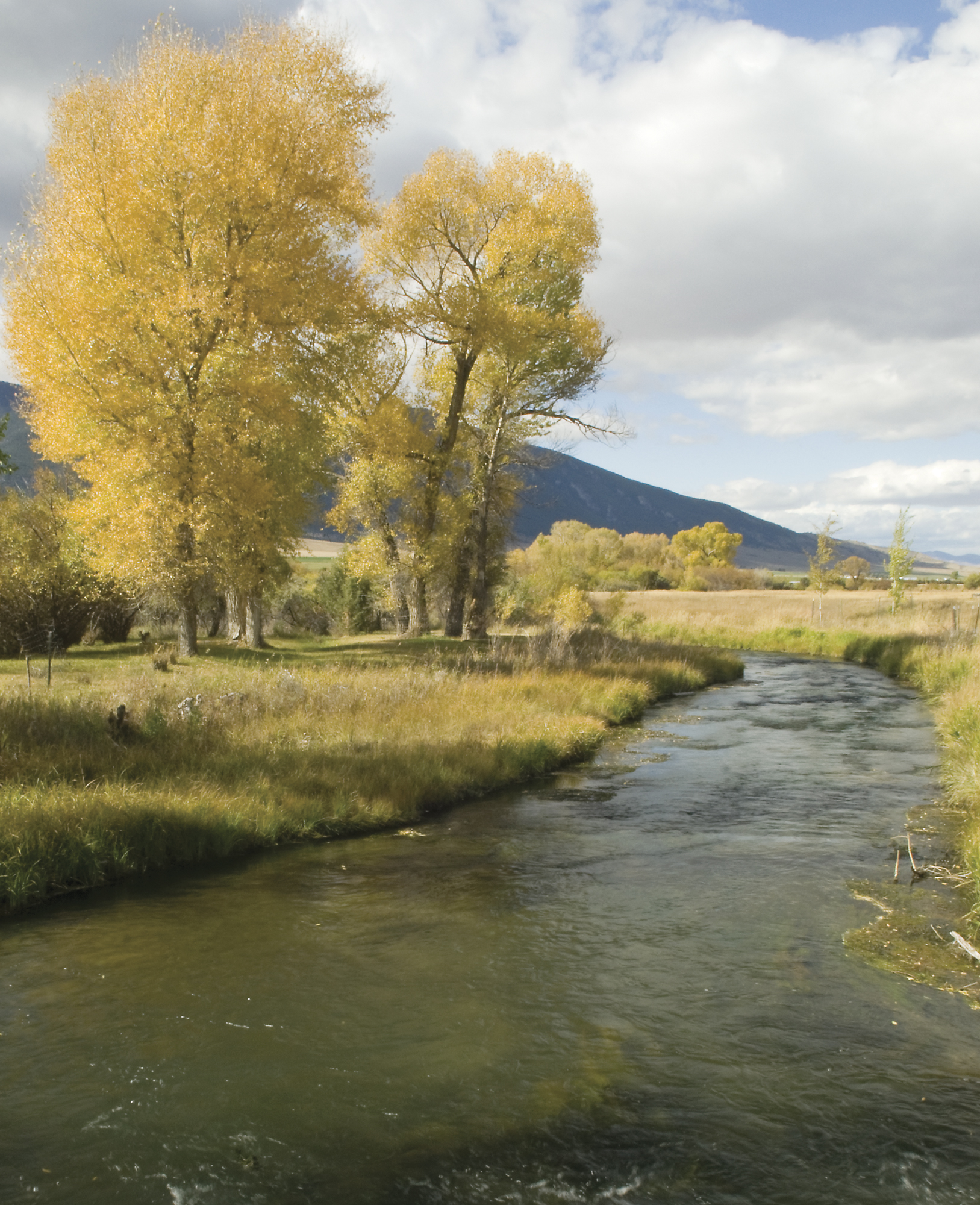
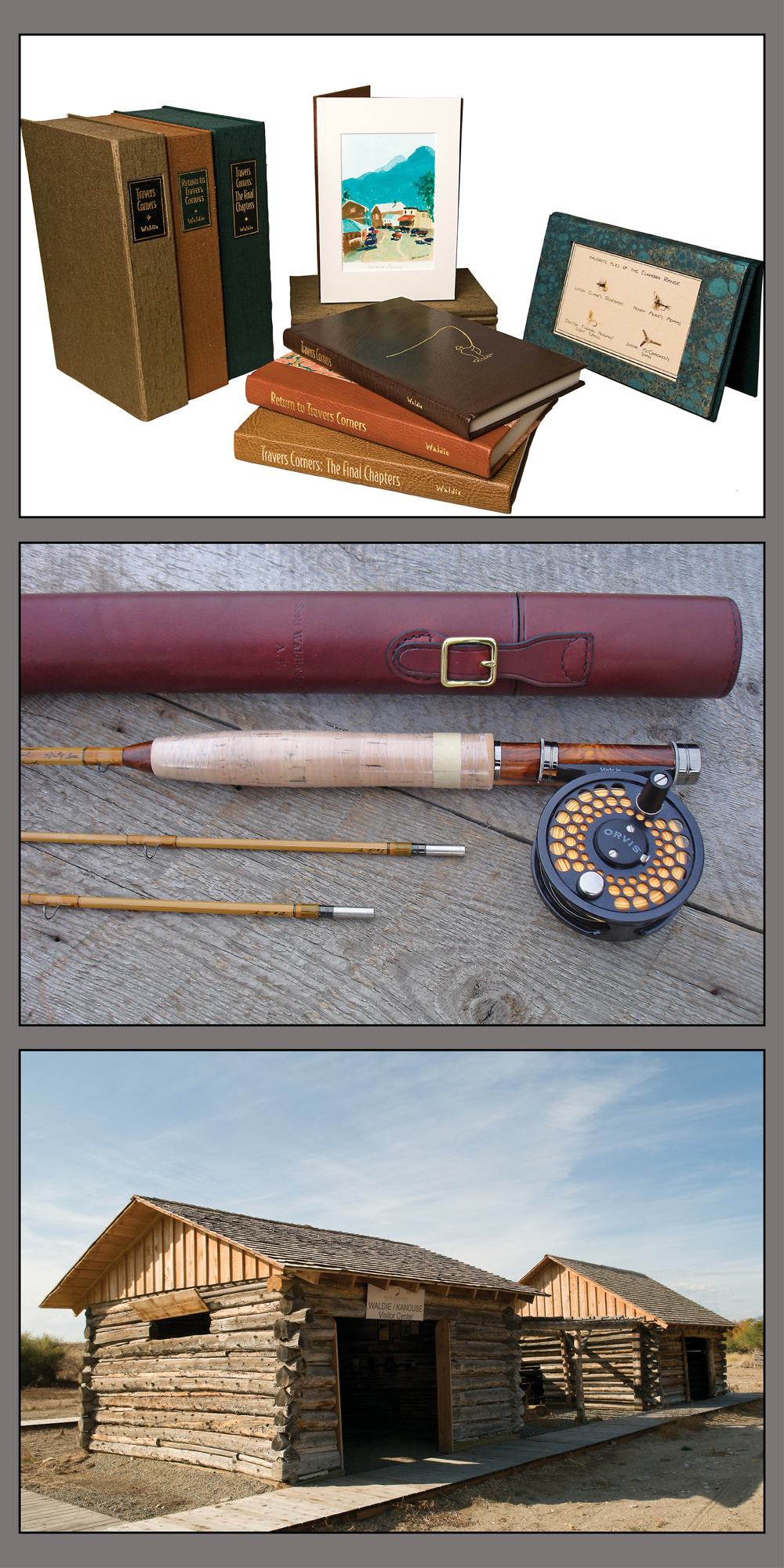
No Comments